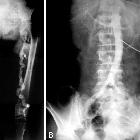Arteriosklerose



Arteriosclerosis is defined by thickening and loss of elasticity of the arterial walls.
There are three patterns (arteriosclerosis is used as a generic term for all patterns above):
- atherosclerosis: large and medium-sized arteries
- Mönckeberg medial calcific sclerosis: muscular arteries
- arteriolosclerosis: small arteries and arterioles
Atherosclerosis
Atherosclerosis is characterized by atheromatous plaques in the intima of large and medium-sized arteries. It is the most common form of arteriosclerosis.
Pathogenesis
Atheromatous plaques begin as fatty streaks composed of lipid-laden macrophages (foam cells). This process begins in childhood but not all fatty streaks progress to plaques.
A plaque is a raised focal lesion within the intima. It comprises a soft necrotic core (predominantly lipids, foam cells and debris) surrounded by chronic inflammatory cells, smooth muscle cells and neovascularization, and covered by a fibrous cap. Plaques often undergo calcification.
The underlying pathogenesis is not completely understood but is believed to involve chronic endothelial injury which results in an inflammatory response, accumulation of lipids, platelet aggregation and activation of smooth muscle cells.
Plaques form most commonly in large elastic arteries (e.g. aorta, carotids, iliacs), and large and medium-sized muscular arteries (e.g. coronary, renal, lower limb, mesenteric and cerebral vessels). They are most prominent at branching points and ostia of major branches.
Advanced plaques may:
- progressively enlarge: causing critical stenosis and ischemia
- ulcerate or rupture (leads to thrombus formation): causing critical ischemia, total occlusion with infarction, or distal embolism
- undergo hemorrhage: causing plaque expansion or rupture
- cause pressure atrophy of underlying media: causing aneurysmal dilatation
Risk factors
- advancing age
- sex (males and postmenopausal females)
- hyperlipidemia
- hypertension
- smoking
- diabetes mellitus
- family history
- homocystinuria
Presentation & complications
- ischemia or infarction (from stenosis, occlusion, or distal embolism)
- heart: acute coronary syndrome (angina, myocardial infarction), cardiac failure, arrhythmia
- brain: TIA, stroke, intracranial atherosclerotic disease
- kidneys: chronic renal impairment, hypertension
- lower limbs: peripheral vascular disease
- gut: mesenteric ischemia or infarction
- aneurysmal dilatation
- thoracic or abdominal aortic aneurysm
- common iliac artery aneurysm
- popliteal artery aneurysm
Radiographic evaluation
- Doppler ultrasound
- CT angiography
- MR angiography
- conventional angiography
Management principles
- control risk factors
- restore blood flow
- thrombolysis (for acute occlusion)
- angioplasty +/- stent
- vascular bypass surgery
- manage complications
Mönckeberg medial calcific sclerosis
Mönckeberg medial calcific sclerosis is characterized by calcific deposits within the media of medium and small muscular arteries that do not cause luminal narrowing. The calcification is typically diffuse and circumferential along the vessel and is readily visible on plain film. Vascular calcification in the breast on mammography is of this type. The exact pathogenesis of Mönckeberg sclerosis is unknown but it is more common with advancing age, diabetes and chronic renal disease.
Arteriolosclerosis
Arteriolosclerosis is characterized by thickening of the walls of small arteries and arterioles. It is most commonly associated with hypertension and diabetes.
There are two types:
- hyaline arteriolosclerosis
- hyperplastic arteriolosclerosis
Hyaline arteriolosclerosis
Seen in the elderly, hypertension, diabetic microangiopathy and benign nephrosclerosis. A leaky endothelium causes plasma components to deposit in arteriolar walls, leading to hyaline thickening of the walls and luminal narrowing. It is the underlying mechanism of small vessel ischemic changes and lacunar infarcts in the brain of hypertensive patients and in most renovascular disease.
Hyperplastic arteriolosclerosis
Seen usually in malignant hypertension. Onion-skin laminated concentric thickening of arteriolar walls causes progressive luminal narrowing. It is associated with necrosis of the vessel wall, referred to as a necrotizing arteriolitis.
History and etymology
It was in 1903, that Johann Georg Mönckeberg, a German pathologist published his findings on medial calcification in arteries in the older population .
Siehe auch:
und weiter:


 Assoziationen und Differentialdiagnosen zu
Assoziationen und Differentialdiagnosen zu 
